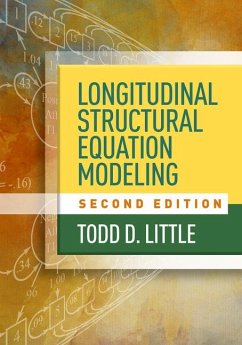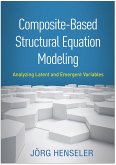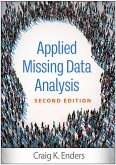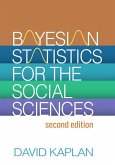Todd D. Little (United States Texas Tech University)
Longitudinal Structural Equation Modeling
Todd D. Little (United States Texas Tech University)
Longitudinal Structural Equation Modeling
- Gebundenes Buch
- Merkliste
- Auf die Merkliste
- Bewerten Bewerten
- Teilen
- Produkt teilen
- Produkterinnerung
- Produkterinnerung
This valuable book is now in a fully updated second edition that presents the latest developments in longitudinal structural equation modeling (SEM) and new chapters on missing data, the random intercepts cross-lagged panel model (RI-CLPM), longitudinal mixture modeling, and Bayesian SEM.
Andere Kunden interessierten sich auch für
![Composite-Based Structural Equation Modeling Composite-Based Structural Equation Modeling]() Jörg HenselerComposite-Based Structural Equation Modeling86,99 €
Jörg HenselerComposite-Based Structural Equation Modeling86,99 €![Applied Missing Data Analysis Applied Missing Data Analysis]() Craig K. Enders (United States Arizona State University)Applied Missing Data Analysis99,99 €
Craig K. Enders (United States Arizona State University)Applied Missing Data Analysis99,99 €![Bayesian Statistics for the Social Sciences Bayesian Statistics for the Social Sciences]() David Kaplan (United States University of Wisconsinâ Madison)Bayesian Statistics for the Social Sciences84,99 €
David Kaplan (United States University of Wisconsinâ Madison)Bayesian Statistics for the Social Sciences84,99 €![Statistics Translated Statistics Translated]() Steven R. TerrellStatistics Translated67,99 €
Steven R. TerrellStatistics Translated67,99 €![Applied Meta-Analysis for Social Science Research Applied Meta-Analysis for Social Science Research]() Noel A CardApplied Meta-Analysis for Social Science Research57,99 €
Noel A CardApplied Meta-Analysis for Social Science Research57,99 €![Machine Learning for Social and Behavioral Research Machine Learning for Social and Behavioral Research]() Ross JacobucciMachine Learning for Social and Behavioral Research77,99 €
Ross JacobucciMachine Learning for Social and Behavioral Research77,99 €![Machine Learning for Social and Behavioral Research Machine Learning for Social and Behavioral Research]() Ross JacobucciMachine Learning for Social and Behavioral Research105,99 €
Ross JacobucciMachine Learning for Social and Behavioral Research105,99 €-
-
-
This valuable book is now in a fully updated second edition that presents the latest developments in longitudinal structural equation modeling (SEM) and new chapters on missing data, the random intercepts cross-lagged panel model (RI-CLPM), longitudinal mixture modeling, and Bayesian SEM.
Hinweis: Dieser Artikel kann nur an eine deutsche Lieferadresse ausgeliefert werden.
Hinweis: Dieser Artikel kann nur an eine deutsche Lieferadresse ausgeliefert werden.
Produktdetails
- Produktdetails
- Verlag: Guilford Publications
- 2 ed
- Seitenzahl: 616
- Erscheinungstermin: 2. Januar 2024
- Englisch
- Abmessung: 261mm x 186mm x 37mm
- Gewicht: 1250g
- ISBN-13: 9781462553143
- ISBN-10: 1462553141
- Artikelnr.: 68449408
- Herstellerkennzeichnung
- Libri GmbH
- Europaallee 1
- 36244 Bad Hersfeld
- gpsr@libri.de
- Verlag: Guilford Publications
- 2 ed
- Seitenzahl: 616
- Erscheinungstermin: 2. Januar 2024
- Englisch
- Abmessung: 261mm x 186mm x 37mm
- Gewicht: 1250g
- ISBN-13: 9781462553143
- ISBN-10: 1462553141
- Artikelnr.: 68449408
- Herstellerkennzeichnung
- Libri GmbH
- Europaallee 1
- 36244 Bad Hersfeld
- gpsr@libri.de
Todd D. Little, PhD, is Professor of Educational Psychology, Leadership, and Counseling at Texas Tech University, in the Research, Evaluation, Measurement, and Statistics program. He is also an Extraordinary Professor at the Optentia Research Focus Area, North-West University, Vanderbijlpark, South Africa. Dr. Little is a Fellow of the American Association for the Advancement of Science; the American Psychological Association (APA) Divisions 5, 7, and 15; and the Association for Psychological Science. He is editor of Guilford's Methodology in the Social Sciences series and past president of APA Division 5 (Evaluation, Measurement, and Statistics). Dr. Little organizes and teaches in his renowned "Stats Camp" (statscamp.org) each June. Partly because of the impact and importance of Stats Camp, Dr. Little was awarded the Cohen Award for Distinguished Contributions to Teaching and Mentoring from APA Division 5 and the inaugural Teaching and Mentoring Award from the Society for Research in Child Development.
Foreword, Noel A. Card 1. Overview and Foundations of Structural Equation Modeling - An Overview of the Conceptual Foundations of SEM - Sources of Variance in Measurement - Characteristics of Indicators and Constructs - A Simple Taxonomy of Indicators and Their Roles - Rescaling Variables - Parceling - What Changes and How? - Some Advice for SEM Programming - Philosophical Issues and How I Approach Research - Summary - Key Terms and Concepts Introduced in This Chapter - Recommended Readings 2. Design Issues in Longitudinal Studies - Timing of Measurements and Conceptualizing Time - Modeling Developmental Processes in Context - Summary - Key Terms and Concepts Introduced in This Chapter - Recommended Readings 3. Modern Approaches to Missing Data in Longitudinal Studies - Planning for Missing Data - Planned Missing Data Designs in Longitudinal Research - Summary - Key Terms and Concepts Introduced in This Chapter - Recommended Readings 4. The Measurement Model - Drawing and Labeling Conventions - Defining the Parameters of a Construct - Scale Setting - Identification - Adding Means to the Model: Scale Setting and Identification with Means - Adding a Longitudinal Component to the CFA Model - Adding Phantom/Rescaling Constructs to the CFA Model - Summary - Key Terms and Concepts Introduced in This Chapter - Recommended Readings 5. Model Fit, Sample Size, and Power - Model Fit and Types of Fit Indices - Sample Size - Power - Summary - Key Terms and Concepts Introduced in This Chapter - Recommended Readings 6. The Longitudinal CFA Model - Factorial Invariance - A Small (Nearly Perfect) Data Example - A Larger Example Followed by Tests of the Latent Construct Relations - An Application of a Longitudinal SEM to a Repeated
Measures Experiment - Summary - Key Terms and Concepts Introduced in This Chapter - Recommended Readings 7. Specifying and Interpreting a Longitudinal Panel Model - Basics of a Panel Model - The Basic Simplex Change Process - Building a Panel Model - Illustrative Examples of Panel Models - Summary - Key Terms and Concepts Introduced in This Chapter - Recommended Readings 8. Multiple-Group Longitudinal Models - A Multiple-Group SEM - A Multiple-Group Longitudinal Model for Conducting an Intervention Evaluation - A Dynamic P-Technique Multiple
Group Longitudinal Model - Summary - Key Terms and Concepts Introduced in This Chapter - Recommended Readings 9. The Random Intercept Cross-Lagged Panel Model, Danny Osborne and Todd D. Little - Problems with Traditional Cross-Lagged Panel Models - The Random Intercept Cross
Lagged Panel Model - Illustrative Examples of the RI
CLPM - Extensions to the RI
CLPM - Final Considerations - Summary - Key Terms and Concepts Introduced in This Chapter - Recommended Readings 10. Mediation and Moderation - Making the Distinction between Mediators and Moderators - Moderation - Summary - Key Terms and Concepts Introduced in This Chapter - Recommended Readings 11. Multilevel Growth Curves and Multilevel SEM - Longitudinal Growth Curve Model - Multivariate Growth Curve Models - Multilevel Longitudinal Model - Summary - Key Terms and Concepts Introduced in This Chapter - Recommended Readings 12. Longitudinal Mixture Modeling: Finding Unknown Groups, E. Whitney G. Moore and Todd D. Little - General Background - Analysis Types - Finite Mixture Modeling Overview - Latent Class Analysis - Latent Profile Analysis - Latent Transition Analysis - Other LTA Modeling Approaches - Developments and Extensions into the Future of Finite Mixture Modeling - Summary - Key Terms and Concepts Introduced in This Chapter - Recommended Readings 13. Bayesian Longitudinal Structural Equation Modeling, Mauricio Garnier-Villarreal and Todd D. Little - The Bayesian Perspective - Bayesian Inference - Advantages of a Bayesian Framework - MCMC Estimation - Bayesian Structural Equation Modeling - Information Criteria - Bayes Factor - Applied Example - Summary - Key Terms and Concepts Introduced in This Chapter - Recommended Readings 14. Jambalaya: Complex Construct Representations and Decompositions - Multitrait-Multimethod Models - PseudöMTMM Models - Bifactor and Higher
Order Factor Models - Contrasting Different Variance Decompositions - Digestif - Key Terms and Concepts Introduced in This Chapter - Recommended Readings References Author Index Subject Index About the Author
Measures Experiment - Summary - Key Terms and Concepts Introduced in This Chapter - Recommended Readings 7. Specifying and Interpreting a Longitudinal Panel Model - Basics of a Panel Model - The Basic Simplex Change Process - Building a Panel Model - Illustrative Examples of Panel Models - Summary - Key Terms and Concepts Introduced in This Chapter - Recommended Readings 8. Multiple-Group Longitudinal Models - A Multiple-Group SEM - A Multiple-Group Longitudinal Model for Conducting an Intervention Evaluation - A Dynamic P-Technique Multiple
Group Longitudinal Model - Summary - Key Terms and Concepts Introduced in This Chapter - Recommended Readings 9. The Random Intercept Cross-Lagged Panel Model, Danny Osborne and Todd D. Little - Problems with Traditional Cross-Lagged Panel Models - The Random Intercept Cross
Lagged Panel Model - Illustrative Examples of the RI
CLPM - Extensions to the RI
CLPM - Final Considerations - Summary - Key Terms and Concepts Introduced in This Chapter - Recommended Readings 10. Mediation and Moderation - Making the Distinction between Mediators and Moderators - Moderation - Summary - Key Terms and Concepts Introduced in This Chapter - Recommended Readings 11. Multilevel Growth Curves and Multilevel SEM - Longitudinal Growth Curve Model - Multivariate Growth Curve Models - Multilevel Longitudinal Model - Summary - Key Terms and Concepts Introduced in This Chapter - Recommended Readings 12. Longitudinal Mixture Modeling: Finding Unknown Groups, E. Whitney G. Moore and Todd D. Little - General Background - Analysis Types - Finite Mixture Modeling Overview - Latent Class Analysis - Latent Profile Analysis - Latent Transition Analysis - Other LTA Modeling Approaches - Developments and Extensions into the Future of Finite Mixture Modeling - Summary - Key Terms and Concepts Introduced in This Chapter - Recommended Readings 13. Bayesian Longitudinal Structural Equation Modeling, Mauricio Garnier-Villarreal and Todd D. Little - The Bayesian Perspective - Bayesian Inference - Advantages of a Bayesian Framework - MCMC Estimation - Bayesian Structural Equation Modeling - Information Criteria - Bayes Factor - Applied Example - Summary - Key Terms and Concepts Introduced in This Chapter - Recommended Readings 14. Jambalaya: Complex Construct Representations and Decompositions - Multitrait-Multimethod Models - PseudöMTMM Models - Bifactor and Higher
Order Factor Models - Contrasting Different Variance Decompositions - Digestif - Key Terms and Concepts Introduced in This Chapter - Recommended Readings References Author Index Subject Index About the Author
Foreword, Noel A. Card 1. Overview and Foundations of Structural Equation Modeling - An Overview of the Conceptual Foundations of SEM - Sources of Variance in Measurement - Characteristics of Indicators and Constructs - A Simple Taxonomy of Indicators and Their Roles - Rescaling Variables - Parceling - What Changes and How? - Some Advice for SEM Programming - Philosophical Issues and How I Approach Research - Summary - Key Terms and Concepts Introduced in This Chapter - Recommended Readings 2. Design Issues in Longitudinal Studies - Timing of Measurements and Conceptualizing Time - Modeling Developmental Processes in Context - Summary - Key Terms and Concepts Introduced in This Chapter - Recommended Readings 3. Modern Approaches to Missing Data in Longitudinal Studies - Planning for Missing Data - Planned Missing Data Designs in Longitudinal Research - Summary - Key Terms and Concepts Introduced in This Chapter - Recommended Readings 4. The Measurement Model - Drawing and Labeling Conventions - Defining the Parameters of a Construct - Scale Setting - Identification - Adding Means to the Model: Scale Setting and Identification with Means - Adding a Longitudinal Component to the CFA Model - Adding Phantom/Rescaling Constructs to the CFA Model - Summary - Key Terms and Concepts Introduced in This Chapter - Recommended Readings 5. Model Fit, Sample Size, and Power - Model Fit and Types of Fit Indices - Sample Size - Power - Summary - Key Terms and Concepts Introduced in This Chapter - Recommended Readings 6. The Longitudinal CFA Model - Factorial Invariance - A Small (Nearly Perfect) Data Example - A Larger Example Followed by Tests of the Latent Construct Relations - An Application of a Longitudinal SEM to a Repeated
Measures Experiment - Summary - Key Terms and Concepts Introduced in This Chapter - Recommended Readings 7. Specifying and Interpreting a Longitudinal Panel Model - Basics of a Panel Model - The Basic Simplex Change Process - Building a Panel Model - Illustrative Examples of Panel Models - Summary - Key Terms and Concepts Introduced in This Chapter - Recommended Readings 8. Multiple-Group Longitudinal Models - A Multiple-Group SEM - A Multiple-Group Longitudinal Model for Conducting an Intervention Evaluation - A Dynamic P-Technique Multiple
Group Longitudinal Model - Summary - Key Terms and Concepts Introduced in This Chapter - Recommended Readings 9. The Random Intercept Cross-Lagged Panel Model, Danny Osborne and Todd D. Little - Problems with Traditional Cross-Lagged Panel Models - The Random Intercept Cross
Lagged Panel Model - Illustrative Examples of the RI
CLPM - Extensions to the RI
CLPM - Final Considerations - Summary - Key Terms and Concepts Introduced in This Chapter - Recommended Readings 10. Mediation and Moderation - Making the Distinction between Mediators and Moderators - Moderation - Summary - Key Terms and Concepts Introduced in This Chapter - Recommended Readings 11. Multilevel Growth Curves and Multilevel SEM - Longitudinal Growth Curve Model - Multivariate Growth Curve Models - Multilevel Longitudinal Model - Summary - Key Terms and Concepts Introduced in This Chapter - Recommended Readings 12. Longitudinal Mixture Modeling: Finding Unknown Groups, E. Whitney G. Moore and Todd D. Little - General Background - Analysis Types - Finite Mixture Modeling Overview - Latent Class Analysis - Latent Profile Analysis - Latent Transition Analysis - Other LTA Modeling Approaches - Developments and Extensions into the Future of Finite Mixture Modeling - Summary - Key Terms and Concepts Introduced in This Chapter - Recommended Readings 13. Bayesian Longitudinal Structural Equation Modeling, Mauricio Garnier-Villarreal and Todd D. Little - The Bayesian Perspective - Bayesian Inference - Advantages of a Bayesian Framework - MCMC Estimation - Bayesian Structural Equation Modeling - Information Criteria - Bayes Factor - Applied Example - Summary - Key Terms and Concepts Introduced in This Chapter - Recommended Readings 14. Jambalaya: Complex Construct Representations and Decompositions - Multitrait-Multimethod Models - PseudöMTMM Models - Bifactor and Higher
Order Factor Models - Contrasting Different Variance Decompositions - Digestif - Key Terms and Concepts Introduced in This Chapter - Recommended Readings References Author Index Subject Index About the Author
Measures Experiment - Summary - Key Terms and Concepts Introduced in This Chapter - Recommended Readings 7. Specifying and Interpreting a Longitudinal Panel Model - Basics of a Panel Model - The Basic Simplex Change Process - Building a Panel Model - Illustrative Examples of Panel Models - Summary - Key Terms and Concepts Introduced in This Chapter - Recommended Readings 8. Multiple-Group Longitudinal Models - A Multiple-Group SEM - A Multiple-Group Longitudinal Model for Conducting an Intervention Evaluation - A Dynamic P-Technique Multiple
Group Longitudinal Model - Summary - Key Terms and Concepts Introduced in This Chapter - Recommended Readings 9. The Random Intercept Cross-Lagged Panel Model, Danny Osborne and Todd D. Little - Problems with Traditional Cross-Lagged Panel Models - The Random Intercept Cross
Lagged Panel Model - Illustrative Examples of the RI
CLPM - Extensions to the RI
CLPM - Final Considerations - Summary - Key Terms and Concepts Introduced in This Chapter - Recommended Readings 10. Mediation and Moderation - Making the Distinction between Mediators and Moderators - Moderation - Summary - Key Terms and Concepts Introduced in This Chapter - Recommended Readings 11. Multilevel Growth Curves and Multilevel SEM - Longitudinal Growth Curve Model - Multivariate Growth Curve Models - Multilevel Longitudinal Model - Summary - Key Terms and Concepts Introduced in This Chapter - Recommended Readings 12. Longitudinal Mixture Modeling: Finding Unknown Groups, E. Whitney G. Moore and Todd D. Little - General Background - Analysis Types - Finite Mixture Modeling Overview - Latent Class Analysis - Latent Profile Analysis - Latent Transition Analysis - Other LTA Modeling Approaches - Developments and Extensions into the Future of Finite Mixture Modeling - Summary - Key Terms and Concepts Introduced in This Chapter - Recommended Readings 13. Bayesian Longitudinal Structural Equation Modeling, Mauricio Garnier-Villarreal and Todd D. Little - The Bayesian Perspective - Bayesian Inference - Advantages of a Bayesian Framework - MCMC Estimation - Bayesian Structural Equation Modeling - Information Criteria - Bayes Factor - Applied Example - Summary - Key Terms and Concepts Introduced in This Chapter - Recommended Readings 14. Jambalaya: Complex Construct Representations and Decompositions - Multitrait-Multimethod Models - PseudöMTMM Models - Bifactor and Higher
Order Factor Models - Contrasting Different Variance Decompositions - Digestif - Key Terms and Concepts Introduced in This Chapter - Recommended Readings References Author Index Subject Index About the Author








